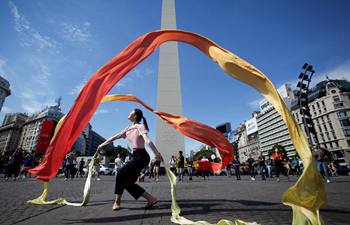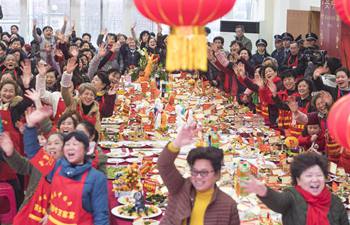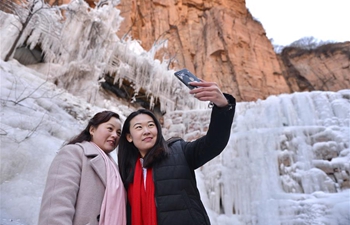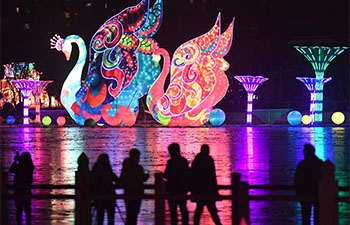 ?
?The Year of the Dog stamp sheet is pictured at the United Nations Postal Administration (UNPA), at the UN headquarters in New York, Feb. 7, 2018. The stamp sheet, consisting of 10 stamps of a denomination of 1.15 U.S. dollars, with the paper-cut images of dogs and UN logo, as the Chinese lunar year for 2018 is the Year of the Dog. This new sheet is the ninth of the UNPA's Lunar New Year stamp series. (Xinhua/Li Muzi)
by Xinhua writer Xie E
UNITED NATIONS, Feb. 9 (Xinhua) -- Unique, auspicious, and absolutely international, a young Chinese couple got a wedding gift for themselves at the United Nations (UN) post office Wednesday - a personalized stamp sheet featuring their snapshot and the Year of the Dog.
Holding their one of a kind stamp sheet in one hand, the fiance, Zhang Ruiyu from China's Shaanxi Province, said he never thought that they could have their own photo on the stamps.
Pointing to the sheet that has the UN Chief Antonio Guterres's image, he said, "As the lunar new year is coming up, I feel double blessed to have such a world-class gift for ourselves."
Ever since the release of the Year of the Dog stamp sheet this February, tourists from around the world, especially from China, came to get a sheet of their own. This can not only be a wedding gift, but a perfect souvenir for everyone.
The stamp sheet, consists of 10 stamps of a denomination of 1.15 U.S. dollars, with the paper-cut images of dogs on the left and UN logo on the right, as the Chinese lunar year for 2018 is the Year of the Dog.
The dogs, in gold and red, the two traditional colors for the Chinese Lunar New Year, or Spring Festival, are designed to add festival color to the most important holiday for Chinese around the world.
The tabs of the stamps and the background design were illustrated by Tiger Pan, a renowned packaging designer, said UNPA.
According to Pan, the inspiration for the animal stamp design arose from "figure-ground reversal," which perfectly interprets the meanings of "cooperation" and "sharing."
The sheet is designed by Sergio Baradat of the UNPA's design team.
Thanawat Amnajanan, Director of the United Nations Postal Administration (UNPA), said he was surprised by the amount of people purchasing the stamps. "I know Chinese love such stamps, but I did not expect they love them so much."
This new sheet is the ninth of the UNPA's Lunar New Year stamp series. Thanawat told Xinhua he came up with the idea of issuing Chinese Lunar New Year themed stamps nine years ago, when it was the Year of the Tiger.
Each Chinese lunar year is represented by one animal zodiac. Traditionally these zodiac animals were used to date the repeating cycle of 12 years. In order, the 12 animals are: Rat, Ox, Tiger, Rabbit, Dragon, Snake, Horse, Goat, Monkey, Rooster, Dog and Pig.
Each animal embodies a typical personality. For example, Rooster is the representative of confidence and intelligence; Ox symbolizes diligence, dependability, strength and determination; Dog is well-known for its loyalty and friendliness with human beings.
Chinese people tend to connect their zodiac to their personality. If you find a person brave and competitive, you can have a bold guess that he was born in the Year of the Tiger.
The Chinese lunar year theme and the UN stamps proved to be a perfect match. Knowing that their photos can be transferred to a pane of stamps makes tourists queue up to get their very own souvenirs.
Qu Wei, Executive Director of Global Youth Center at Tsinghua University, who led a team of students to visit the UN, bought three stamp sheets for his family. He said this special stamp would surely help spread Chinese culture to the world.
The United Nations is the only organization in the world which is neither a country nor a territory that can issue postage stamps. It is also the only postal authority to issue stamps in three different currencies, namely U.S. dollars, Swiss francs and Euro. UN stamps are issued simultaneously at UN offices in New York, Geneva and Vienna. The first UN stamps were issued in U.S. dollar denominations on United Nations Day in 1951.















